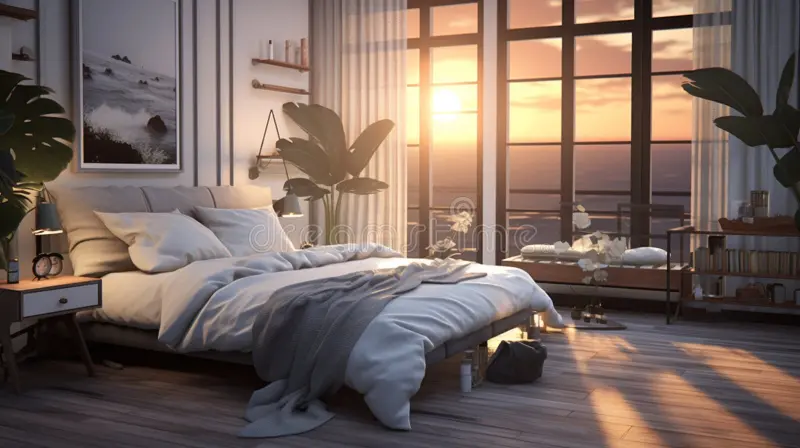Crafting a Serene Oasis: Exploring Minimalist Interior Design
Share this:

Minimalist interior design epitomizes simplicity and elegance, creating spaces that are uncluttered yet inviting. This design philosophy focuses on clean lines, muted color palettes, and functional furniture, offering a tranquil retreat from the chaos of everyday life. In this narrative, we delve into the essence of minimalist interior design, uncovering its core principles and exploring its significance in contemporary living spaces.
As we navigate through the essential elements, color schemes, furniture choices, space optimization strategies, and lighting techniques of minimalist interiors, a world of understated sophistication unfolds before us, inviting us to embrace a lifestyle of simplicity and harmony.
Introduction to Minimalist Interior
Minimalist interior design is a style characterized by simplicity, clean lines, and a focus on functionality. It involves using a minimal amount of furniture and decorative elements to create a sleek and uncluttered space. The key principles of minimalist interior design include:Key Principles of Minimalist Interior Design
- Avoiding clutter: Minimalist spaces are free of unnecessary items, creating a sense of calm and order.
- Neutral color palette: Colors are often kept simple and muted, such as whites, grays, and earth tones, to create a sense of serenity.
- Clean lines: Furniture and architectural details feature clean, straight lines to maintain a sense of simplicity and sophistication.
- Functional furniture: Pieces are chosen for their practicality and functionality, with a focus on quality over quantity.
Elements of Minimalist Interior
Minimalist interior design is characterized by simplicity, clean lines, and a focus on functionality. The essential elements of minimalist interiors include:Clean Lines
In minimalist interior design, clean lines are crucial to creating a sense of simplicity and order. Furniture and architectural elements should have straight, simple lines without any unnecessary ornamentation.Simple Color Palettes
Minimalist interiors often feature a neutral color palette, such as whites, grays, and earth tones. These simple colors help create a sense of calm and serenity in the space.Functional Furniture
Functionality is key in minimalist interior design. Furniture should be carefully selected to serve a purpose and avoid cluttering the space. Multi-functional pieces are often used to maximize space.Natural Light
Natural light plays a crucial role in minimalist interiors, as it helps to create a sense of openness and airiness. Large windows, skylights, and strategically placed mirrors are often used to maximize natural light in the space.Textures and Materials
Textures and materials are carefully chosen in minimalist interiors to add visual interest without overwhelming the space. Materials such as wood, metal, and glass are commonly used to create a sense of balance and harmony.Color Schemes in Minimalist Interior
Color schemes play a crucial role in defining the aesthetics of minimalist interiors. The most popular colors used in minimalist design include white, beige, and grey. These neutral tones create a sense of calmness, simplicity, and sophistication.Color Psychology in Minimalist Design
Color psychology greatly influences the choice of colors in minimalist interiors. White is associated with purity and cleanliness, making it a common choice for walls and furniture. Beige exudes warmth and tranquility, while grey provides a sense of balance and timelessness.Maintaining a Monochromatic Color Palette
In minimalist interiors, maintaining a monochromatic color palette is significant as it helps create a cohesive and harmonious look. By sticking to shades of a single color, such as various tones of grey or beige, the space appears more unified and visually appealing. This approach also enhances the minimalist aesthetic by reducing visual clutter and distractions.Furniture and Accessories in Minimalist Interior
When it comes to creating a minimalist interior, the choice of furniture and accessories plays a crucial role in achieving a clean and clutter-free look. In minimalist design, less is more, and every piece of furniture or accessory should serve a purpose while maintaining a sense of simplicity and elegance.Type of Furniture for Minimalist Design
In a minimalist interior, furniture should be functional, sleek, and free of unnecessary embellishments. Opt for pieces with clean lines, geometric shapes, and neutral colors. Some examples of furniture that complement minimalist design include simple sofas, low-profile beds, streamlined dining tables, and storage units with hidden compartments.Concept of “Less is More” in Furniture Selection
When selecting furniture and accessories for a minimalist interior, it is essential to adhere to the principle of "less is more." Avoid overcrowding the space with furniture and decorations. Instead, focus on a few key pieces that stand out and create a sense of openness. Choose quality over quantity and prioritize items that are both functional and visually appealing.Tips for Decluttering and Organizing Spaces
To maintain a minimalist look in your interior, decluttering and organizing are essential steps. Start by getting rid of items that are no longer needed or do not serve a purpose. Store away belongings that can create visual clutter and only display a few carefully selected accessories. Invest in storage solutions such as hidden cabinets, shelves, and multi-functional furniture to keep the space tidy and organized.Maximizing Space in Minimalist Interior
When it comes to small minimalist interiors, maximizing space is essential to maintain the clean and uncluttered aesthetic. By strategically organizing and utilizing the available space, you can create a sense of spaciousness even in a compact area.Importance of Negative Space in Minimalist Design
Negative space, also known as white space, is crucial in minimalist design as it helps to balance the visual elements in a room. Having empty spaces between furniture and decor items allows the eye to rest and creates a sense of calm and openness.Strategies for Maximizing Space in Small Minimalist Interiors
- Choose multi-functional furniture pieces that serve dual purposes, such as a sofa bed or a storage ottoman.
- Utilize vertical space by installing wall shelves or cabinets to keep the floor area free from clutter.
- Opt for furniture with legs to create a sense of openness and lightness in the room.
- Use light colors for walls and furniture to reflect natural light and make the space feel larger.
Creating a Sense of Openness and Airiness
To enhance the feeling of openness and airiness in a minimalist space, consider the following:- Keep decor and accessories to a minimum to avoid overcrowding the space.
- Use mirrors to reflect light and create the illusion of a larger space.
- Incorporate plants or greenery to bring a touch of nature indoors and add freshness to the room.
- Opt for sheer curtains or blinds to allow natural light to filter through and brighten up the space.
Lighting in Minimalist Interior
Lighting plays a crucial role in enhancing minimalist interiors by creating a sense of space, highlighting key design elements, and setting the overall ambiance of the room. In minimalist design, lighting is not only functional but also serves as a design element in itself.Ambient Lighting
Ambient lighting provides overall illumination to the room, creating a warm and inviting atmosphere. In minimalist interiors, ambient lighting is often achieved through recessed lights, track lighting, or wall sconces. The goal is to evenly distribute light throughout the space without overwhelming the simplicity of the design.Task Lighting
Task lighting is essential in minimalist interiors to provide focused light for specific activities such as reading, cooking, or working. In minimalist design, task lighting is typically incorporated through desk lamps, pendant lights, or under-cabinet lighting. The key is to place task lighting strategically to ensure adequate illumination without cluttering the space.Accent Lighting
Accent lighting is used to highlight architectural features, artwork, or other focal points in minimalist interiors. This type of lighting adds visual interest and depth to the space. In minimalist design, accent lighting can be achieved with adjustable track lights, wall washers, or picture lights. The goal is to create a layered lighting effect that enhances the overall aesthetic of the room.Tips for Achieving a Well-Lit Minimalist Space
- Choose lighting fixtures that complement the clean lines and simplicity of minimalist design.
- Opt for fixtures with neutral or monochromatic finishes to blend seamlessly with the space.
- Consider the placement of lighting fixtures to avoid casting harsh shadows or creating visual clutter.
- Use dimmer switches to control the intensity of light and create different moods in the space.
- Maximize natural light by keeping windows unobstructed and using sheer curtains or blinds.

